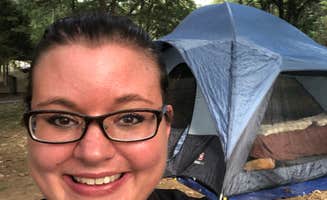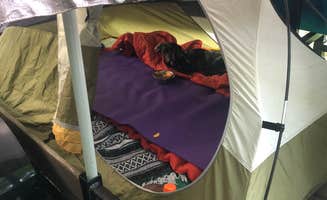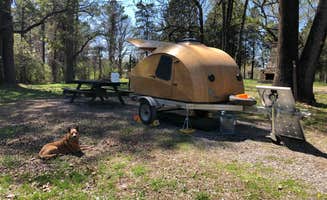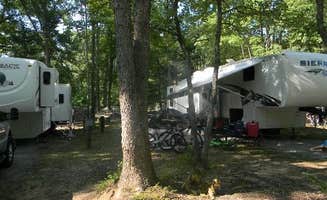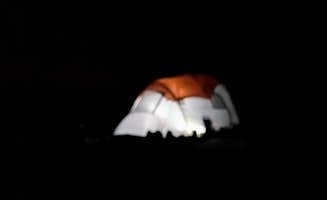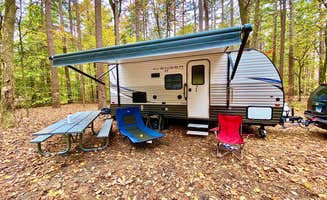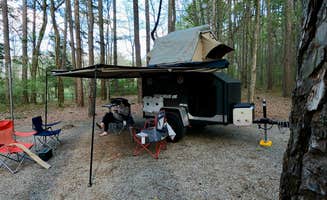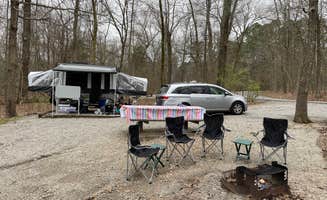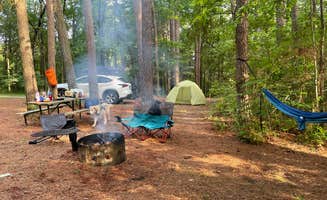Shawnee National Forest dominates the landscape surrounding Cave-In-Rock, Illinois, with elevations ranging from 300 to 1,000 feet above sea level. The region's limestone bedrock creates distinct geological features throughout the camping areas, including natural arches, rocky overhangs, and the namesake cave formation along the Ohio River. Campsites near Cave-In-Rock experience humid subtropical climate with hot summers regularly exceeding 90°F and mild winters, often maintaining accessible camping conditions year-round.
What to do
Hiking at Garden of the Gods: The unusual rock formations provide extensive trail systems with varying difficulty levels. At Pharaoh Campground, visitors find excellent access to these trails. "The rock formations are surreal and shoulder season is so quiet! We will be back as the hiking is awesome," notes one visitor. The observation trail is approximately 1/4 mile long and offers expansive views across the wilderness.
Swimming at natural pools: During summer months, several natural swimming areas provide relief from the heat. Bell Smith Springs features multiple swimming holes along a network of hiking trails. According to a camper at Redbud Campground, "We found small pools perfect for a summer dip. Half the hikers were carrying towels so it must be a common plan." The main swimming area is accessible via a short hike from the campground.
Riverside activities: The Ohio River provides fishing, boating, and wildlife viewing opportunities. "The campground is right on the Ohio river..and is very open. It has a great view of the Ohio river and across you can see Kentucky," reports a visitor at Tower Rock Campground. Fishing for catfish, bass, and crappie is popular, with best catches reported in early morning and evening hours.
What campers like
Seasonal variety: Campers appreciate the different experiences available throughout the year. Fall foliage transforms the forests around camping areas. A camper at Pine Ridge Campground noted, "The campground is very rustic with a LOT of shade which made our stay there perfect." Many sites report lower crowds in spring and fall with more comfortable temperatures.
Budget-friendly options: The area offers affordable camping compared to more developed regions. One camper at Pounds Hollow Recreation Area commented, "At only $10 per night, this is a great deal." Most primitive campsites in the region range from $5-15 per night, with electric sites typically costing $15-25.
Dark night skies: The remote location creates excellent stargazing conditions away from light pollution. "Dark and quiet at night unless you have loud fellow campers," mentions a visitor at Tower Rock. Several campgrounds report minimal artificial lighting, allowing for unobstructed views of the night sky.
What you should know
Limited cell coverage: Prepare for unreliable communication in most camping areas. A camper at Camp Cadiz Campground advises: "This camp ground is only about 10 min from Garden Of The Gods. It's down a gravel road a bit but nothing too hard to find." Many visitors recommend downloading maps in advance and bringing paper backups.
Water access varies: Not all campsites provide drinking water, especially during off-seasons. "The vault toilet and water supply worked just fine for us and our kids," reports a Bell Smith Springs camper. However, another noted: "The drinking water pump is broke so you must bring your own water."
Seasonal hazards: Be aware of poison ivy along trails during warmer months. A Garden of the Gods visitor warned: "We camped in the backcountry along the River to River trail adjacent to Garden of the Gods. The camping area we found was great, about 7 miles down the River to River trail, but there was poison ivy everywhere along the trail which made for a stressful hike."
Tips for camping with families
Swimming opportunities: Several locations offer kid-friendly water activities during summer. A visitor to Cave-in-Rock State Park mentioned: "There is a playground near the showerhouse and a pond back in behind the playground." Natural swimming areas provide alternatives to traditional swimming pools.
Educational experiences: The region's unique geology offers learning opportunities. "The cave has some pretty interesting history it was once a hideout for river pirates," noted one camper. Several sites have interpretive signs explaining the natural formations and their historical significance.
Spacing between sites: Some campgrounds provide more privacy than others. A camper at Pine Ridge reported: "The campground was very quiet. In fact, we were the only ones in the campground while we stayed." Families seeking more seclusion should consider weekday visits during shoulder seasons.
Tips from RVers
Hookup availability: Electric sites are limited and often fill quickly during peak seasons. At Timber Ridge Outpost & Cabins, an RVer reported: "Paid $35 per night for 2 nights after our Passport America discount. Full hookups. 50amp, water (55psi), and sewer." Call ahead for reservations at developed campgrounds, especially for weekend stays.
Road conditions: Many access roads are unpaved or minimally maintained. "The roads are paved and easy to navigate," notes one Timber Ridge camper, but many other campgrounds require driving on gravel roads with limited turnaround space for larger rigs. RVers with larger vehicles should research site access before arrival.
Leveling challenges: Several campgrounds feature uneven terrain requiring additional equipment. A camper at Redbud Campground observed: "Decent primitive sites, not very level though. Good for tent camping or small camper." Bring leveling blocks and consider site location carefully when setting up.


